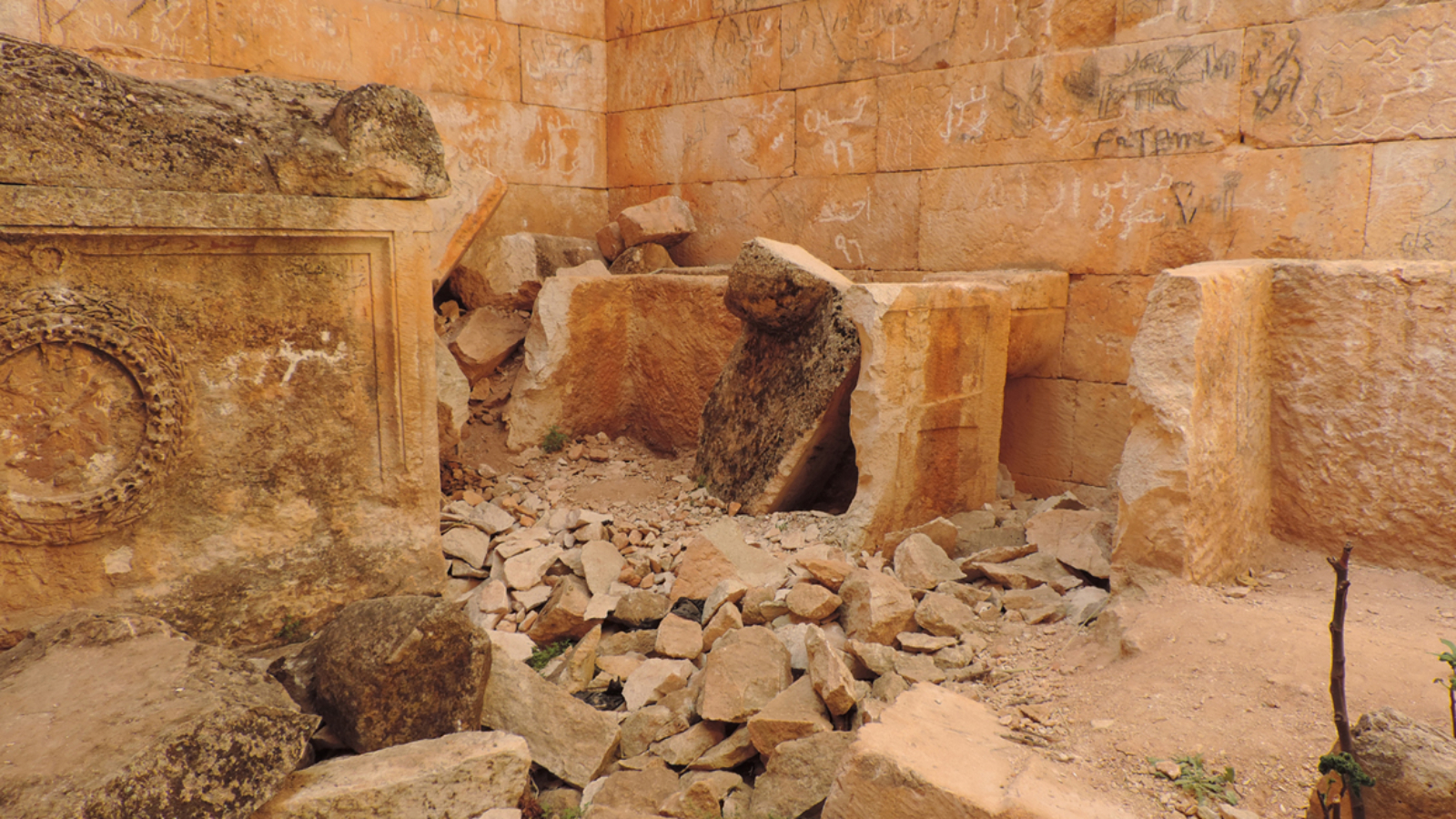This article was orginally published on Syria Deeply.
By Khaled Al Khatib and Mais Istanbelli
On Jan. 16, 2015, fighters from armed Islamist groups stormed the Nabhaniya Sufi School in Aleppo, the largest city in Syria. Including fighters from several factions – Jabhat al Nusra (the Nusra Front), al Jabha al Shamiyya (the Levant Front), Ahrar al Sham, and others – the group of attackers destroyed the tomb of Sheikh Mohammed Nabhan, the school’s founder. The men proceeded to desecrate the graves of Nabhan’s wife, brother, and son.
Attacks on sites and shrines affiliated with the Sufi strand of Islam are part of the broader campaign by groups like Jabhat al Nusra and Islamic State to erase Syrian cultural and historical heritage that doesn’t mesh with their literalist interpretation of religion.
Mahmoud, 48, recalled the event. “The area was cordoned off [the evening of the attack] and civilians were not allowed to approach it until they [the fighters] had finished digging up the graves,” he told Syria Deeply, adding that more than 100 armed fighters were present. “They were not even masked and didn’t hide their identities from the public because they believe that what they did was sanctioned by Sharia law.”
Two days later, the Sharia Court in Aleppo issued a statement mandating the transfer of all tombs inside mosques to Islamic cemeteries. The statement was also endorsed by military factions, including Jabhat al Nusra, the Islamic Front, Jaysh al Mujahadeen, and Harakat Fajr al Islam.
Salafist factions, who generally dominate opposition-controlled areas, have differences with the Sufi interpretation of Islam and have also accused Sufis of supporting Syrian President Bashar al Assad’s regime. Worshipping at tombs, for instance, is a Sufi spiritual practice that Salafists denounce as heretical.
Abu Qays, a 32-yea- old Sharia law teacher from Aleppo, explained that Salafist movements have gained popular support among the general public in opposition controlled areas. Explaining that he supports the destruction of Sufi shrines, he told Syria Deeply: “The demolition of shrines is necessary. Their [Sufis’] adoration of graves and tombs is a sign of idolatry.”
Rabie, 40, is one of the few Sufi sheikhs who stayed in opposition controlled areas as the situation became increasingly tense for followers of Sufism. Speaking to Syria Deeply, he said that he cannot publicly speak out against the destruction of shrines for fear of punishment. “Digging up and demolishing graves is forbidden in Islam,” he explained. “The sanctity of the human body should be respected whether it’s dead or alive.”
According to the sheikh, there are only rare instances in which excavating graves is permitted. “Even [in those cases], the body should be treated with the utmost respect,” he commented. “The trend of digging up graves, bombing them, or burning them is foreign to us.”
Sheikh Mohammed Nabhan’s tomb wasn’t the only one targeted by Salafist militants. Shrines have been razed and bombed in places across Syria, including in Daraa, Raqqa, Damascus, Deir Ezzor, and elsewhere.
Sheikh Muhammad Jrabeh’s tomb in Aleppo was flattened by opposition groups in Aleppo in June 2011, and the tomb of Rih – a prominent Sufi sheikh – was later demolished in Azaz. In 2012, Shiekh Muhammad Adib Hassoun’s tomb was damaged by regime shelling. It’s not only shrines that militant groups have targeted. In Syria and Iraq, the Islamic State and other groups have destroyed museums and ancient artifacts. In March, the Islamic State released a video of its fighters smashing statues in the Mosul Museum in Iraq.
As Syria Deeply recently reported, concerns for the safety of historic sites in Palmyra – designated a World Heritage site by UNESCO – arose after the Islamic State overran the area earlier this year. The group recently released a gruesome video of 25 Syrian soldiers being executed by teenagers in front of Palmyra’s Roman amphitheater.
After Jabhat al Nusra and the Islamic State split in the spring of 2013, the groups ostensibly intensified their efforts to erase Sufi religious shrines from Syria’s landscape. In September 2014, the Islamic State destroyed several Sufi tombs in the Deir Azzour area, according to an Arabic language report published by al Arabiyya.
In March 2014, the Islamic State bombed the Shekh Ageel al Manbiji mosque and the Sheikh Hilal mosque, both near Aleppo. Later that month, they destroyed two more mosques in Raqqa, the Islamic State stronghold. Although none of those mosques were Sufi, they each housed shrines that worshippers often visited. Many Syrians are outraged by the attacks on the heritage of their country’s diverse community of religious and ethnic groups. Abu Abdo, 84, dismissed the Salafists’ claim that Sufis support the Assad regime. A follower of Sheikh Nabhan, he explained that Sufi leaders, among them Sheikh Nabhan, successfully lobbied for the constitution to stipulate that the president must be a Muslim in 1973.
“Sheikh Nabhan and many others rejected the [first draft] of the constitution and al Assad bowed to the people’s demands and changed the constitution,” he told Syria Deeply. “Destroying [Nabhan’s] tomb contributes to the obliteration of the Syrian identity.”
*****
*****
Khaled Al Khatib and Mais Istanbelli are contributers at Syria Deeply, an independent media project dedicated to advancing foreign policy literacy through public service journalism.
[Photo courtesy of Syria Deeply]
